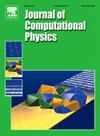Sequential data assimilation for PDEs using shape-morphing solutions
IF 3.8
2区 物理与天体物理
Q2 COMPUTER SCIENCE, INTERDISCIPLINARY APPLICATIONS
引用次数: 0
Abstract
Shape-morphing solutions (also known as evolutional deep neural networks, reduced-order nonlinear solutions, and neural Galerkin schemes) are a new class of methods for approximating the solution of time-dependent partial differential equations (PDEs). Here, we introduce a sequential data assimilation method for incorporating observational data in a shape-morphing solution (SMS). Our method takes the form of a predictor-corrector scheme, where the observations are used to correct the SMS parameters using Newton-like iterations. Between observation points, the SMS equations—a set of ordinary differential equations— are used to evolve the solution forward in time. We prove that, under certain conditions, the data assimilated SMS (DA-SMS) converges uniformly towards the true state of the system. We demonstrate the efficacy of DA-SMS on three examples: the nonlinear Schrödinger equation, the Kuramoto–Sivashinsky equation, and a two-dimensional advection-diffusion equation. Our numerical results suggest that DA-SMS converges with relatively sparse observations and a single iteration of the Newton-like method.
基于形状变形解的偏微分方程序列数据同化
形状变形解(也称为进化深度神经网络、降阶非线性解和神经伽辽金格式)是一类逼近时变偏微分方程解的新方法。在这里,我们介绍了一种将观测数据纳入形状变形解(SMS)的顺序数据同化方法。我们的方法采用预测校正方案的形式,其中观测值用于使用类似牛顿的迭代来校正SMS参数。在观测点之间,使用SMS方程(一组常微分方程)使解及时向前发展。证明了在一定条件下,数据同化后的SMS (DA-SMS)一致收敛于系统的真实状态。我们在三个例子上证明了DA-SMS的有效性:非线性Schrödinger方程,Kuramoto-Sivashinsky方程和二维平流扩散方程。我们的数值结果表明,DA-SMS收敛于相对稀疏的观测和单次迭代的类牛顿方法。
本文章由计算机程序翻译,如有差异,请以英文原文为准。
求助全文
约1分钟内获得全文
求助全文
来源期刊

Journal of Computational Physics
物理-计算机:跨学科应用
CiteScore
7.60
自引率
14.60%
发文量
763
审稿时长
5.8 months
期刊介绍:
Journal of Computational Physics thoroughly treats the computational aspects of physical problems, presenting techniques for the numerical solution of mathematical equations arising in all areas of physics. The journal seeks to emphasize methods that cross disciplinary boundaries.
The Journal of Computational Physics also publishes short notes of 4 pages or less (including figures, tables, and references but excluding title pages). Letters to the Editor commenting on articles already published in this Journal will also be considered. Neither notes nor letters should have an abstract.
 求助内容:
求助内容: 应助结果提醒方式:
应助结果提醒方式:


